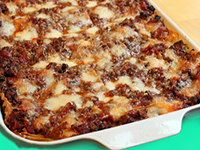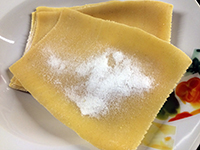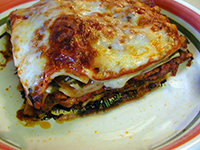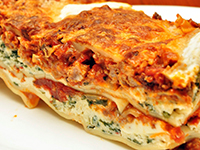 |
Lasagne |
 Homemade lasagne noodles. |
 Traditional Lasagne al forno from Italy. |
 American-Italian lasagne made with ricotta cheese. |
Going back in time to trace the origins of this dish, the first to go is the latest addition, tomatoes. Tomatoes are a New World ingredient and did not appear in European cuisine until the 16th century. Around 1390 in England, a cookbook named The Forme of Cury (The Method of Cooking) was written by the cooks of King Richard II. "Cury" is an Old English word for "cuisine", meaning to cook, boil, or grill. The scroll is an extensive collection of medieval English recipes and includes a lasagne recipe that has similarities in both its name and the recipe, which involved layering of ingredients between pasta sheets.
Loseyns
from The Forme of Cury, cookbook of king King Richard II, 1390Take gode broth and do in an erthen pot, take flour of payndemayn and make therof past with water. and make therof thynne foyles as paper with a roller, drye it harde and seeth it in broth take Chese ruayn grated and lay it in disshes with powdour douce and lay theron loseyns isode as hoole as thou mizt. and above powdour and chese, and so twyse or thryse, & serue it forth.
This of course does not mean it was the English who invented the dish. The Forme of Cury was a collection of recipes of Spanish, French, Italian, and Arab cuisines, and was written partly to compete with Le Viandier of Taillevent, a French cookbook created around the same time. Lasagne had been mentioned before, in one of the oldest medieval cookbooks, the Liber de Coquina (The Book Of Cookery), dating back to the beginning of the 14th century and written by an unknown author, most likely in Naples. The book is written in Latin. An electronic version can be read at the University Of Giessen (http://www.staff.uni-giessen.de/gloning/tx/mul2-lib.htm), while one of the two surviving copies is stored at the Bibliothèque nationale in Paris.
However, the origins of the actual sheets of lasagna pasta go much farther back in time - to Ancient Rome. References to flat pasta dishes are found in the ancient Rome dating back to the 3rd century BC. Cicero himself speaks about his passion for Laganum, wide strips of long pasta made of wheat flour pasta shaped as wide and flat sheets).
But the essential idea of flat sheets of flour-based dough go even farther back to Ancient Greece. Naples was founded by the Bronze Age Greeks nearly 4000 years ago. (In fact, Naples is one of the oldest continuously inhabited cities in the world.) When the Greeks founded Naples, they adopted a local dish made by the natives, made up by flour pasta and water dried to the sun, called macaria. It appears that in this most basic form, lasagne belong to the family of basic staple foods common to many cultures around the world. For example, in Aztec times, way before the Europeans arrived in the Americas, flat sheets made of corn flour (corn tortillas) were eaten either plain or dipped in mole or a chili pepper sauce, or filled with turkey meat, eggs, beans, honey, squash, and chile peppers.

 |
Classic Italian lasagna (Lasagne al forno alla Bolognese) from Pierluigi Corradini |
The first recipe is a classic Lasagne al forno alla Bolognese, baked lasagne using ragù alla bolognese for the red sauce, and béchamel for the white sauce. This is how lasagna is made in the lasagna of Emilia-Romagna region.
Ingredients:
- 2 lbs (1 kg) Ragù alla bolognese
- 1 lb (500 g) fresh lasagne noodles
- 3 1/3 cup (800 ml) Béchamel sauce
- Butter for the pan
- 3.5 oz (100 g) Parmigiano Reggiano, grated
Preparation:
- 1 lb egg noodles and 2 lbs ragù usually takes 5 layers in a 35x25 cm baking dish.
- The preparation of lasagne always starts with the sauces. It is recommended to prepare the ragù a day before. Follow this recipe here: Ragù alla bolognese (allow 8-10 hours for this step).
- Cut the pasta sheets to the required size to line the baking dish. Boil the pasta sheets a minute on each side, then drain and put them to dry on a clean cloth.
- At this point the sauces should be ready and warm. Butter the baking dish and layer the bottom with the layer of the sauce, rich in oil.
- Start building the lasagna. Put a layer of the pasta, red sauce, white sauce and a handful of the parmesan. Build 5 layers in this manner, ending with the parmesan.
- Cover with aluminum foil and bake at 390 deg F (200 deg C) for 30 minutes.
- Remove the foil, and continue cooking for another 10 minutes. To achieve a better browned surface, turn on the broiler and continue cook for another 5 minutes.
- Once out of the oven, let stand the lasagna at least 10 minutes before serving.
- YIELD: Serves 8
Preparation with dried pasta
- If using store-bought dry pasta, use 30% less (e.g. 350 g, 3/4 lb for this recipe).
- Dried pasta should be boiled for half the time on the box. Ensure that the sauce is spread evenly and that the dry pasta is completely submerged.
Emilia-Romagna has this recipe, but other regions have developed their own. In Liguria, a simple but delicate regional specialty has developed consisting of thin lasagna sheets layered with fragrant pesto and lightly baked. In the Marche region, the recipe goes to the other extreme with a famously rich lasagna that includes chicken livers, cream, Marsala wine, veal ragù, and sometimes truffles and mozzarella.

 |
American-Style Lasagna from John Chandler |
This second recipe is an American-style lasagna. The original Italian recipe evolved when Italian immigrants poured into the United States during the immigration boom of the early 20th century. In Italy, lasagna has never been an everyday dish. It has been reserved for a momentous occasion, such as a wedding (Marche region), the birth of a child (Emilia-Romagna region), or the traditional Christmas meal (Puglia region). It was also a relatively expensive dish to make because meat was costly in southern Italy. But when Neapolitan immigrants arrived in America they discovered that meat was cheap and plentiful. Although they could not find the same quality olive oil, mozzarella or tomatoes as in Italy, they made do, albeit at the cost of taste suffering a bit. More compromises followed as American cooks sought further ways simplify the dish. Curly-edged dried lasagna noodles became as common as dried spaghetti, and the hard-boiled eggs, sausage and meatballs were dropped. The long-simmered ragù meat sauce, which alone can take 10 hours to prepare, became browned hamburger meat added to canned tomato sauce. Ricotta was replaced with cottage cheese.
Lasagna is not intended as a catchall for whatever ingredient there is at hand. The thin, delicate pasta should not be overwhelmed by a landfill of stuff jammed between the layers. The Emilia-Romagna recipe with a moderate amount of meat sauce along with a little white sauce to maintain moistness should be the goal.
This American recipe uses "Italian sausage", which is a style of pork sausage seasoned with fennel or anise. This is the main ingredient of the red sauce. See our essay about American sausage for a recipe. The white sauce is replaced with ricotta cheese. It was posted online in 2002 by John Chandler, a Dallas home cook, on AllRecipes.com 11 years ago. It was featured in 2013 by ABC News as the most popular recipe on the website with tens of million views, more than 12,000 likes, over 27,000 Pinterest shares, and close to 8,000 mostly 5-star reviews. It is a recipe that simply ticks the right boxes on the American palate, without being generic and a depository for leftovers.
Ingredients:
- 500 g(1 lb) sweet Italian sausage
- 350 g (3/4 lb) lean ground beef
- 1/2 cup minced onion
- 2 cloves garlic, crushed
- 1 800 ml (28 oz) can crushed tomatoes
- 2 200 ml (6 oz) cans tomato paste
- 1 400 ml (12 oz) can canned tomato sauce
- 1/2 cup water
- 2 tbsp white sugar
- 1 1/2 tsp dried basil leaves
- 1/2 tsp fennel seeds
- 1 tsp Italian seasoning
- 1 tbsp salt
- 1/4 tsp ground black pepper
- 4 tbsp fresh parsley, chopped
- 12 lasagne noodles
- 500 ml (16 oz) ricotta cheese
- 1 egg
- 1/2 tsp salt
- 3/4 lb mozzarella cheese, sliced
- 3/4 cup Parmesan cheese, grated
Preparation:
- In heavy skillet, cook the sausage, ground beef, onion, and garlic over medium heat until well browned.
- Stir in the crushed tomatoes, tomato paste, tomato sauce, and water. Season with sugar, basil, fennel seeds, Italian seasoning, 1 tablespoon salt, pepper, and 2 tablespoons parsley. Simmer, covered, for about 1 1/2 hours, stirring occasionally.
- Bring a large pot of lightly salted water to a boil. Cook lasagna noodles in boiling water for 8 to 10 minutes. Drain the noodles and rinse with cold water.
- In a bowl, combine the ricotta cheese with the egg, remaining parsley, and 1/2 teaspoon salt.
- Preheat oven to 375 degrees F (190 degrees C).
- To assemble the dish, spread 1 1/2 cups of the meat sauce in the bottom of a 9x13 inch (25x35 cm) baking dish. Arrange 6 lasagne noodles lengthwise over meat sauce. Spread with one half of the ricotta cheese mixture. Top with a third of mozzarella cheese slices. Spoon 1 1/2 cups meat sauce over the mozzarella, and sprinkle with 1/4 cup Parmesan cheese. Repeat layers, and top with remaining mozzarella and Parmesan cheese.
- Cover with foil and bake in the preheated oven for 25 minutes. Remove the foil, and bake an additional 25 minutes. Cool for 15 minutes before serving.
- YIELD: Serves 12
back to Radim and Lisa's Well-Travelled Cookbook | email us
Last updated: March 19, 2017